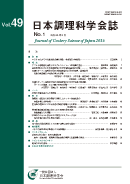Volume 49, Issue 1
Displaying 1-14 of 14 articles from this issue
- |<
- <
- 1
- >
- >|
Review
-
2016Volume 49Issue 1 Pages 1-6
Published: 2016
Released on J-STAGE: March 01, 2016
Download PDF (909K)
Original paper
-
2016Volume 49Issue 1 Pages 7-18
Published: 2016
Released on J-STAGE: March 01, 2016
Download PDF (1156K) -
2016Volume 49Issue 1 Pages 19-25
Published: 2016
Released on J-STAGE: March 01, 2016
Download PDF (1128K) -
2016Volume 49Issue 1 Pages 26-34
Published: 2016
Released on J-STAGE: March 01, 2016
Download PDF (1292K) -
2016Volume 49Issue 1 Pages 35-42
Published: 2016
Released on J-STAGE: March 01, 2016
Download PDF (1079K)
Note
-
2016Volume 49Issue 1 Pages 43-48
Published: 2016
Released on J-STAGE: March 01, 2016
Download PDF (952K)
Technical report
-
2016Volume 49Issue 1 Pages 49-57
Published: 2016
Released on J-STAGE: March 01, 2016
Download PDF (1152K) -
2016Volume 49Issue 1 Pages 58-64
Published: 2016
Released on J-STAGE: March 01, 2016
Download PDF (1198K) -
2016Volume 49Issue 1 Pages 65-73
Published: 2016
Released on J-STAGE: March 01, 2016
Download PDF (896K) -
2016Volume 49Issue 1 Pages 74-81
Published: 2016
Released on J-STAGE: March 01, 2016
Download PDF (1224K)
Course text
-
2016Volume 49Issue 1 Pages 82-88
Published: 2016
Released on J-STAGE: March 01, 2016
Download PDF (1312K)
Educational materials research
-
2016Volume 49Issue 1 Pages 89-92
Published: 2016
Released on J-STAGE: March 01, 2016
Download PDF (979K)
Cooking room
-
2016Volume 49Issue 1 Pages 93-97
Published: 2016
Released on J-STAGE: March 01, 2016
Download PDF (1178K)
Topics & opinion
-
2016Volume 49Issue 1 Pages 98-99
Published: 2016
Released on J-STAGE: March 01, 2016
Download PDF (711K)
- |<
- <
- 1
- >
- >|
